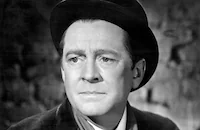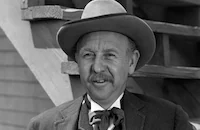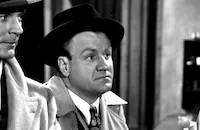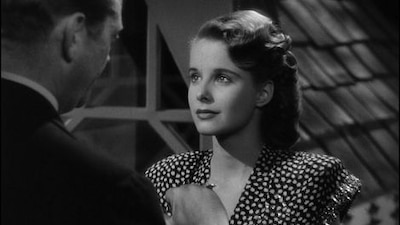That Brennan Girl

Brief Synopsis
Cast & Crew
Alfred Santell
James Dunn
Mona Freeman
William Marshall
June Duprez
Frank Jenks
Film Details

Synopsis
On Mother's Day, 1946, in San Francisco, Ziggy Brennan thinks back on the events which have brought her to this day: In 1938, young Ziggy's mother Natalie makes her pretend they are sisters and call her Nat, and teaches her how to trick men into giving her money. By the time she is a young adult, Ziggy's ambition and wiles attract a fellow con artist, Denny Reagan. Although Denny's pious mother worries for his soul and donates all the money he gives her to the church, he continues to work scams, and convinces Ziggy to help him. One evening at a nightclub, Ziggy meets a simple, handsome soldier, Mart Neilson, whose watch Denny admires. Ziggy steals it, but Denny later sees the watch's inscription from Mart's mother, and demands Ziggy return it. When she finds Mart, he insists that she date him, and although she admits that she stole the watch and brings him to spy on her mother as she cons a man into giving her money, Mart continues to love Ziggy. Days later, they marry and Ziggy becomes pregnant, but Mart is soon killed in combat. Around the same time, Denny is arrested and sent to the penitentiary. Soon after, Nat decides to marry and tells Ziggy to find her own apartment. When the baby, Martha, is born, the neighbors help Ziggy learn to care for her. Ziggy loves Martha, but continues to remember her mother's scornful prediction that she will be a bad mother who will only want to carouse. When a teenager, Olivette, offers to babysit, Ziggy hires her and begins to go out nightly, unaware that Olivette is leaving the baby alone as soon as she falls asleep. When Martha is eight months old, Denny is released from prison and visits Ziggy. He has reformed and wants her to do the same, and together they care for Martha during the day and go out each night. One night, Olivette leaves with her boyfriend and Martha falls out of her crib and almost chokes to death on the sheets. After Ziggy's landlady sends Martha to the juvenile authorities, Ziggy attacks her and is arrested. During her trial, Ziggy's neighbors accuse her of being neglectful, and the court places Martha in an orphanage. Denny shuns Ziggy for being a bad mother, and she soon becomes despondent. After Ziggy spurns Denny's mother's offer of help, she runs to the church. There she finds an abandoned child on a pew and takes him home. Months later, Denny is about to leave for Florida when he passes by Golden Gate Park and sees Ziggy with the baby, Denny, Jr. He checks up on her and, upon discovering that she is a model mother, begins a relationship with her again. Soon, Ziggy returns to the court, where the judge admonishes her for taking in a child but recognizes that she has become a devoted mother and returns Martha to her care. After Denny, Ziggy, Martha and Denny, Jr. leave the courthouse together, he asks her to marry him.

Director
Alfred Santell
Cast

James Dunn

Mona Freeman
William Marshall

June Duprez
Frank Jenks
Dorothy Vaughan

Charles Arnt

Rosalind Ivan

Fay Helm
Bill Kennedy
Connie Leon
Edythe Elliott
Sarah Padden
Jean Stevens

Lucien Littlefield

Marian Martin
Shirley Mills
Gordon Wynne

Peter Leeds
Charles Quigley
Thomas Dillon
Isabel Withers
Arthur Space
Gaylord Pendleton
Charles Flynn
Joan Blair

James Kirkwood
Josephine Whittell
Ralph Sanford
Chester Clute
Helen Brown
Tommy Ryan

Paul Harvey

Louis Jean Heydt
Ruth Robinson
Frances Morris
Charles Sullivan
Barbara Jean Wong
Duke Johnson
Harry Johnson
Guy Zanette
Daral Hudson
Tom Burton
Keith Richards
Murray Yeats
Max Wagner
Eddie Hart
Fred Santley
Earle Hodgins
Harry Depp
Lester Dorr
Mary Newton
Joy Gwynell
Walden Boyle
Spencer Chan
Linda Johnson
Beatrice Gray
Bebe Allen
Dorothy Miller
Dorothy Granger

Lyle Latell
Stanley Blystone
Michael Branden
Bert Moorhouse
Ben Erway
Eva Novak
Janet Warren
Torchy Rand
Sherry Hall
Cay Forester
Gloria Franklin
Dorothy Crider
Helen Gerald
Rita Lynn
Myron Healey
Mary Maynard
Barbara Bettinger
Charles Mitchell
Crew
Doris Anderson
George Antheil
John T. Bourke
Earl Crain Sr.
Cy Feuer
Peggy Gray
Russell Kimball
Jerry Livingston
Howard Lydecker
Theodore Lydecker
Bob Mark
Jack Marta
John Mccarthy Jr.
Dick Moder
Al J. Neiburg
Adele Palmer
Lewis Physioc
Arthur Roberts
Alfred Santell
Gordon Schaefer
Otto Siegel
Adela Rogers St. Johns
James Sullivan
Marty Symes
Jack Warren
Howard Wilson

Videos
Movie Clip



Hosted Intro
Film Details

Articles
That Brennan Girl
The film stars Mona Freeman as the daughter of a neglectful single mother (June Duprez) who grows into a cynical woman against the backdrop of San Francisco. Eventually she too becomes a single mother, but she is determined not to let history repeat itself. James Dunn, fresh off his Oscar-winning performance in A Tree Grows in Brooklyn (1945), is on hand as an Irish racketeer who takes an interest in Freeman and her child.
The underrated Santell had directed for many major studios dating back to 1917. In an unpublished 1972 interview with William Dorward, held in the Academy's Margaret Herrick Library in Beverly Hills, Santell explained how he came to direct his final two features for Republic, which at the time was seen as practically a Poverty Row studio. An old friend of his, James Granger, had lost his job as an executive at Fox and been hired by Republic, where he wanted to "change the whole tenor" of the studio by bringing in top directors like John Ford, Irving Cummings and Santell to make prestige pictures. "Because of my great friendship for Jimmy Granger, I fell for this thing," recalled Santell. He struck a deal with Republic chief Herbert J. Yates that allowed him autonomy as producer and director, and then he called on his old friend Adela Rogers St. John to write an original story for what was meant to be his first Republic feature: That Brennan Girl. St. John was a top writer who had previously worked with Santell on the hit World War I themed drama The Patent Leather Kid (1927).
Meanwhile, Yates called Santell in for a meeting and asked if he was "a company man." Yates had just struck a deal with someone he called "the hottest property I think there is to be in pictures": a Mexican singing star named Tito Guizar. Santell later described Guizar as "the Mexican Elvis Presley"--he didn't mean it as a compliment--and the next thing he knew, he found himself roped into directing a movie starring this singer, Mexicana (1945), which Santell said "nearly did me in" because of all the interference from Yates.
Only after Mexicana did Santell finally start work on That Brennan Girl, and Yates interfered again. In a key early scene, for instance, a girl holding some flowers she has picked for her mother climbs three flights of steps in a tenement; she opens the door, finds her mother with another man, and drops the flowers, with the camera capturing their fall all the way to the ground. Yates argued that one flight was enough and that building a set with three flights would be too costly and unnecessary. It was an utterly typical criticism from the penny-pinching Yates, but it drove Santell crazy; he said it was simply one of many similar squabbles he had to endure throughout production. After the film, Santell quit his contract, left Republic, and never made another film, mainly because "Yates personified the executive that was going to take over the industry. You have him today at every large studio, and you can see the results of the lack of showmanship, the lack of knowledge of story value." Yates tried hard to lure Santell back in order to make a picture starring Yates's wife, Vera Ralston, but Santell declined.
Despite the drama behind the scenes, That Brennan Girl was well received upon its release on December 23, 1946. "[Santell] gets high quality production out of limited materials and his direction works script and actors for full value," said Variety. "Femmes looking for a chance to enjoy a binge of good, wholesome, tear-compelling sentiment can't go wrong with That Brennan Girl. The film has three distinct types of mothers, a cute baby, a wayward son who reforms, a girl who starts bad but makes good."
Many critics had high marks for Freeman, with the Los Angeles Times praising her "quiet skill and sincerity" and The Hollywood Reporter predicting the film "should establish young Mona Freeman."
The film was re-issued in 1951 under the title Tough Girl. In 2018, it was re-released in a fine restoration thanks to Martin Scorsese's Film Foundation and the work of Paramount preservationists led by Andrea Kalas.
By Jeremy Arnold

That Brennan Girl
Quotes
Trivia
Notes
A New York Times article from May 1946 states that street and harbor scenes were shot on location in San Francisco, CA. Mona Freeman was borrowed from Paramount for her role. According to the file on the film in the MPAA/PCA Collection in the AMPAS library, PCA director Joseph I. Breen had many issues with the original drafts of this film's script and ordered several re-writes. In 1951, the film was re-edited and released as Tough Girl.















